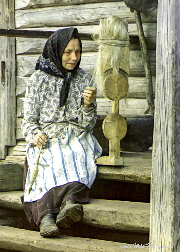|
 a) What is a Distaff? a) What is a Distaff?
b) St Distaff’s Day
c) Types of flax distaff (opens a new page)
d) Make a cone distaff (opens a new page)
e) Preparing flax for the distaff (opens a new page)
f) Dressing a flax distaff (opens a new page)
What is a Flax Distaff?
A distaff is any device used for holding unspun fibres, usually long fibres such as flax and hemp. The distaff acts as a ‘third hand’ helping to keep the fibres in order. The word distaff comes from dis [low German for a bunch of flax] and staff [stick].
Some distaffs attach to an arm on the spinning wheel while others require a stand. It is not necessarily an advantage to have a distaff attached to the spinning wheel. An attached distaff is sometimes too close to the orifice of the wheel which can make drafting more difficult. With a free-standing distaff you can adjust both its height and its distance from the orifice and therefore place it in an ideal position. Traditionally the distaff is placed to your left, but with a free standing distaff you can choose whether to have it to your left or your right, depending on which side you find it easier to draft from.
Arranging the fibres on the distaff is called ‘dressing the distaff’ and a ribbon is usually used to hold the fibres in place. You need a flax strick to dress a distaff as flax tops are not suitable. A strick is a bunch of hackled flax (or hemp or jute) where the fibres are 45 to 60 cm in length. Flax tops on the other hand consist of short lengths of flax (about 15 cm) which are overlapped to make a continuous top and can be spun without a distaff, just like wool. Stricks are usually prepared by hand whilst tops are prepared by machine, hence the price difference.
St Distaff’s Day
St Distaff’s Day falls on the 7th January which is the day after twelfth night or the day after Epiphany. It marks the end of the Christmas festivities, when women resume their household tasks. Men celebrate Plough Monday, the 1st Monday after Epiphany, which sometimes falls on the same day as St Distaff’s Day.
Even though there is no connection with any saint, St Distaff’s Day marks the importance of spinning in the calendar. For thousands of years all the yarn needed for weaving clothes, sails and household textiles was spun by hand. It was necessary to spin whenever there was a spare moment and women of all classes were expected to spend some time spinning.
The 1500s saw the introduction of the spinning wheel which sped up the production of yarn. As a result there was an expansion of grazing land for sheep to cater for a thriving export market for woollen textiles. Spinning became even more important and St Distaff Day’s was an important date in the calendar.
You can follow a tradition that is more than a thousand years old by organising a gathering on St Distaff’s day in your fibre community or craft group. Another way to celebrate this date is by learning how to dress a distaff and by making a start on spinning a strick of flax.
Next:-
Spinning flax & flax distaffs
a) Types of flax distaff
b) Making a cone distaff
c) Preparing flax for the distaff
d) Dressing a flax distaff
e) Spinning flax from a distaff (in preparation)
Top of page
|

